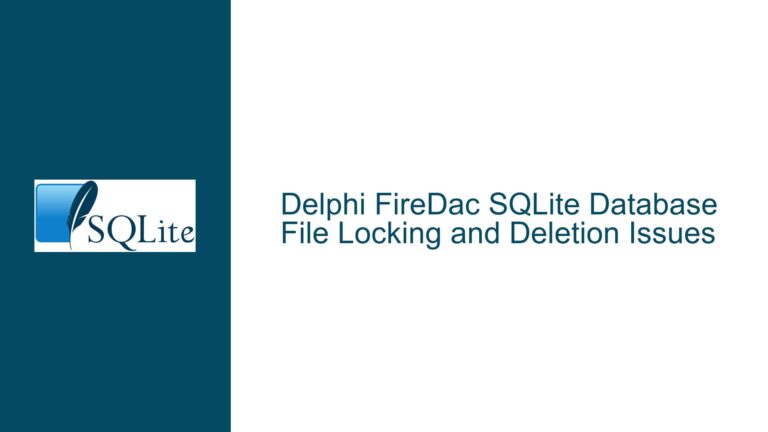and Resolving SQLite szExtra Size Requirement for Page Cache
SQLite Page Cache szExtra Must Be At Least sizeof(void*)
The SQLite page cache mechanism is a powerful feature that allows applications to define custom memory management strategies for database pages. One of the lesser-documented requirements of this feature is that the szExtra parameter, which specifies the amount of extra space allocated for each page in the cache, must be at least the size of a pointer (sizeof(void*)). This requirement is not explicitly stated in the official SQLite documentation, but it is enforced in the SQLite source code. Failure to adhere to this requirement can lead to subtle bugs, memory corruption, or even crashes in applications that use custom page caches.
The szExtra parameter is part of the sqlite3_pcache_methods2 structure, which defines the methods for a custom page cache implementation. When an application initializes a custom page cache, it must specify the size of the extra space (szExtra) that SQLite should allocate for each page. This extra space can be used by the application to store additional metadata or context information associated with each page. However, SQLite internally requires that this extra space be at least as large as a pointer. This is because SQLite uses this space to store internal pointers for managing the page cache.
The lack of explicit documentation for this requirement can lead to confusion and errors, especially for developers who are implementing custom page caches for the first time. In the case of TeXnicard, a program that uses SQLite’s custom page cache feature, the developer discovered this requirement only after examining the SQLite source code. This highlights the importance of understanding not just the documented behavior of SQLite, but also the implicit requirements that are enforced by its implementation.
Misalignment Between Documentation and Implementation Leading to Undefined Behavior
The core issue arises from a misalignment between the SQLite documentation and its implementation. The documentation for the sqlite3_pcache_methods2 structure and the szExtra parameter does not explicitly state that szExtra must be at least sizeof(void*). This omission can lead developers to assume that any non-negative value for szExtra is valid, which is not the case. When szExtra is smaller than sizeof(void*), SQLite’s internal mechanisms that rely on this extra space for pointer storage will fail, leading to undefined behavior.
The SQLite source code enforces this requirement by assuming that szExtra is large enough to store a pointer. Specifically, SQLite uses the extra space to store pointers for managing the page cache’s linked lists and other internal data structures. If szExtra is too small, these pointers will overwrite adjacent memory, leading to memory corruption. This corruption can manifest in various ways, including crashes, data loss, or silent data corruption.
The lack of explicit documentation for this requirement is particularly problematic because it affects a relatively advanced feature of SQLite. Custom page caches are typically used by applications that require fine-grained control over memory management, such as embedded systems or high-performance databases. These applications often operate under strict resource constraints, making it critical to understand and adhere to all requirements for custom page cache implementations.
Ensuring szExtra Meets SQLite’s Internal Requirements
To resolve this issue, developers must ensure that the szExtra parameter is at least sizeof(void*) when implementing a custom page cache. This can be done by explicitly checking the value of szExtra during the initialization of the custom page cache. If szExtra is smaller than sizeof(void*), the application should either adjust the value or fail gracefully with an error message.
In addition to ensuring that szExtra meets the minimum size requirement, developers should also consider the alignment requirements of the platform on which SQLite is running. On some platforms, pointers must be aligned to specific boundaries for optimal performance or even correct operation. Therefore, it is a good practice to round up szExtra to the nearest multiple of the platform’s pointer alignment requirement.
For example, on a 64-bit platform where pointers are 8 bytes and must be aligned to 8-byte boundaries, szExtra should be set to at least 8 bytes, and preferably a multiple of 8 bytes. This ensures that the extra space allocated for each page is properly aligned and can be used efficiently by SQLite’s internal mechanisms.
To further mitigate the risk of memory corruption, developers should also consider using defensive programming techniques when implementing custom page caches. This includes adding assertions or runtime checks to verify that szExtra meets the minimum size requirement and that the extra space is properly aligned. These checks can help catch errors early and provide meaningful error messages that guide developers toward the correct implementation.
In conclusion, the requirement that szExtra must be at least sizeof(void*) is a critical but under-documented aspect of SQLite’s custom page cache feature. Developers who implement custom page caches must be aware of this requirement and take steps to ensure that their implementations adhere to it. By doing so, they can avoid subtle bugs, memory corruption, and crashes, and ensure that their applications operate reliably and efficiently with SQLite.






